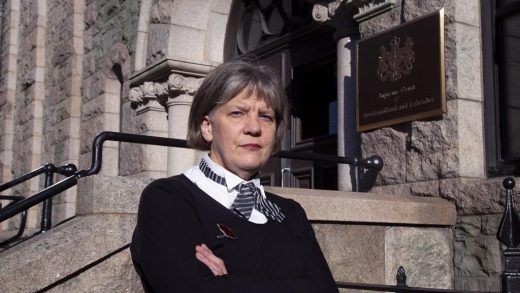Theatrical flying service helps ‘Peter Pan’ performers soar high above the stage

In Peter Pan, you can fly if you think of a wonderful thought. Any happy little thought. All it takes is faith, trust and pixie dust — and Harry Christensen.
It’s a Saturday afternoon and Christensen, a flying director with the theatrical flying service Flying by Foy, is in town from Las Vegas teaching RWB company members how to take flight for this week’s production of Peter Pan, which runs from May 3 to 7 at the Centennial Concert Hall.
Dance preview
Peter Pan
Royal Winnipeg Ballet
● Centennial Concert Hall
● Wednesday to Sunday
● Tickets at rwb.org
Established in 1957 by Peter Foy, Flying by Foy has sprinkled the proverbial pixie dust on thousands of productions of Peter Pan, including four Broadway iterations and the NBC television production of Peter Pan Live!
Christensen, who has been flying with Foy for almost 25 years, has history with RWB’s Peter Pan. When choreographer Jorden Morris set about adapting the J.M. Barrie classic about the boy who never grows up, Flying by Foy sent Christensen to help create the flight sequences for the ballet, which made its première in Winnipeg in 2006.
The alternating casts of Pans, Wendys and Tinker Bells are all at the RWB warehouse for their harness fittings and flight lessons. Christensen has big dad energy; he’s an amiable coach, underlining the importance of safety.
PHOTOS BY JESSICA LEE / WINNIPEG FREE PRESS Royal Winnipeg Ballet dancer Chenxin Liu, who alternates in the role of Tinker Bell in RWB’s upcoming production of Peter Pan, practises flying during a rehearsal with flight expert Harry Christensen.
The dancers are suspended in the air by two hip-width wires, with gears at the hip of the harness so that they can do all manner of back and front flips.
Navigating that space proves tricky for the Pans, because men’s shoulders tend to be wider than their hips. For the Tinker Bells, revolutions require finding a balance between their muscular legs and lighter upper bodies. There are costume considerations as well; Tinker Bell has smaller wings to accommodate the wires.
And they have to make it all look like magic.
The flying the dancers will be doing is manual, which means they will be pulled up and lowered back to earth by cables operated by actual people.
“Don’t cue us unless you want to go up,” Christensen reminds the dancers. “If you don’t want to go up, you don’t go up, and then we can talk about it after the show.”
“The hardest thing for the dancer sometimes is to let us share control, if you will, because we’re literally partnering with them, we’re literally performing with them, which is why I like manual flying better than automated, personally.”–Harry Christensen
Later in the rehearsal, Christensen motions for the dancers to gather around for an important reminder.
“It’s just a show,” he says in mock whisper. “Your safety is more important to me than a show. Your career is more important to me than one show. It’s just a show.”
Christensen has worked on many, many ballets, with many, many dancers.
“I love ballet because the flying is so elegant. It’s not as aggressive as a musical,” Christensen says during a break. “The hardest thing for the dancer sometimes is to let us share control, if you will, because we’re literally partnering with them, we’re literally performing with them, which is why I like manual flying better than automated, personally.”
Getting up into the sky also requires the dancers to ignore some of their most ingrained impulses.
“You jumped into it a little bit, didn’t you?” Christensen asks Yue Shi, who is alternating in the role of Peter Pan with Liam Saito, during rehearsal. “You can raise your feet but don’t jump.”
“It’s harder for the males (to share control) because they’re not used to it,” Christensen says later. “The females are used to partnering and having somebody lead them and lift them. But the males aren’t.”
JESSICA LEE / WINNIPEG FREE PRESS Dancers Liam Saito, who plays Peter Pan, and Liu practise a scene where Peter catches Tinkerbell.
“It’s a different feeling for us to have to relinquish that control to another person, for sure,” says Saito after his first flight lesson. Peter Pan is a big show for Saito, who was called up from the corps de ballet to perform in his first title role.
“I’m used to having the ground to push off of and generate force. So, the feeling of weightlessness and figuring out how to flip by changing my centre already suspended in the air was an interesting experience.”
Amanda Solheim, who will be alternating in the role of Tinker Bell with Chenxin Liu, is also a first-time flier.
“I was really nervous going into it but once I got up there I felt super safe,” she says. “You get up there and you’re a little higher than normal, and then (Harry) asks you to flip and then it’s like, ‘You’re really gonna make me flip right now?’”
Principal dancers Elizabeth Lamont and Alanna McAdie, who will be alternating as Wendy Darling, are not new to flight; both danced in the role in 2016. But they still remember what it was like to swing out over the orchestra pit for the first time.
“I felt like my stomach dropped,” McAdie says. “It’s higher and faster than you think.”
“It’s pretty scary,” Lamont says. “I do have a fear of heights, so it’s not great. But the fun part for Wendy, when we fly, we always hold Peter Pan’s hand.”
JESSICA LEE / WINNIPEG FREE PRESS Peter Pan is a big show for dancer Liam Saito, who was called up from the corps de ballet to perform in his first title role.
The Wendys and Pans must dance in their harnesses for the whole show, which adds a physical challenge when it comes to range of movement. McAdie says the fact she’s danced in the harness before has helped her mentally prepare for what’s to come.
“Whereas, last time, you put so much work in the studio and then to feel like you’ve lost some of that right when you get to the shows, it’s kind of scary,” she says. “And you kind of have to let it be because you don’t have full control over that.”
Indeed, flying is a lesson in letting go. Faith, trust and pixie dust. Christensen recalls the words of his late boss, another Peter who could fly.
“Mr. Foy, God rest his soul, used to always say that our systems are just an OSHA-required safety system in case they forget their happy thoughts.”
Jen Zoratti
Columnist
Jen Zoratti is a Winnipeg Free Press columnist and author of the newsletter, NEXT, a weekly look towards a post-pandemic future.
Read full biography
Credit: Theatrical flying service helps ‘Peter Pan’ performers soar high above the stage


